 Menu
Menu
|
School Spano |

|
||
|
Function To show the functioning of the pile. | |||
|
|||
|
Description It is formed by fifty superimposed cooper-zinc couples held by a glass or ebonite column in the centre. | |||
|
School Castelvì, Spano, Pellegrini |

|
||
|
Function To show the functioning of the pile. | |||
|
|||
|
Description Chromic acid cell or bichromate cell. The model is formed with two carbon electrodes with raising zinc. The container has the form of a spherical bottle. The capacity is one litre. | |||
|
School Spano |
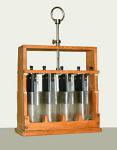
|
||
|
Function To study the connection between piles. | |||
|
|||
|
Description The four piles of prismatic shape are contained in a beech wood case, thus has two lateral columns destined to held the mobile system of the zinc-carbon groups. The immersion happens without complicate devices, similar to the device of the Grenet’s pile. During the descent, the group that is immerses stops on two elastic pads, that avoiding the risk of breaking in the case in which the operator should leave the control ring. In the rest position the four containers are kept covered with a glass plate. | |||
|
School Spano |

|
||
|
Function To show the functioning of the pile. | |||
|
|||
|
Description It is formed by a cylindrical glass, a porous jar, prismatic carbon, cylindrical zinc with binding posts for the zinc and the carbon. The glass is 16 cm high. | |||
|
School Spano |
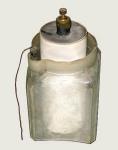
|
||
|
Function To show the functioning of the cell. | |||
|
|||
|
Description It is formed by a prismatic glass, a porous jar with agglomeration of manganese dioxide, a plane sheet zinc, binding posts for the zinc and the carbon. The glass is 16 cm high. | |||
|
School Azuni |
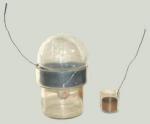
|
||
|
Function To show the functioning of the cell. | |||
|
|||
|
Description Copper sulfate cell. It is formed by a glace container with a narrow neck. An electrode is formed by a zinc plate cylinder from which a wire branches. The other electrode branches from a little cup placed inside the container. | |||
|
School Spano |
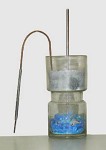
|
||
|
Function To show the functioning of the cell. | |||
|
|||
|
Description It is formed by a cylindrical vase with a central narrowing. In the upper side we place a cylindrical zinc plate immerged in a zinc sulphate solution. A copper electrode is immerged in a solution of sulphate copper. It rises from the lower side of the vase and its form is partly a spiral with an insulating protection on its top. The cell supplies a constant current for a long time. | |||
|
School Azuni |
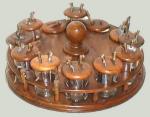
|
||
|
Function To show the functioning of the cells in series. | |||
|
|||
|
Description On a wooden tray we place twelve glasses that act as cells for Volta’s piles. The glasses are covered with wooden disks that hold the electrodes. The cells are connected in series. | |||
|
School Spano |

|
||
|
Function Reproduction of Seebeck’s classic apparatus. | |||
|
|||
|
Description It is formed by a copper-nickel silver couple. By heating the welding a current passes, enhanced by the rotation of a magnetic needle. | |||
|
School Azuni |

|
||
|
Function To show the functioning of the cell. |
|||
|
|||
|
Description It is a thermoelectric cell formed by 63 elements placed inside a cylindrical ebonite container with a lid. Two brass binding posts are present on the sides of the container. | |||
|
School University (1), Spano (2) |
 (2) (2)
|
||
|
Function To show the functioning of a dry cell. |
|||
|
|||
|
Description It is formed by many disks of silver or golden paper held by an ebonite bar, and pressed between two terminal armatures. These hold a hook and a binding post (to hang the cell). The cell is divided into two parts by a protruding aluminium disk that is used to block it in the metallic container. The internal surface of the container presents a seam that obliges the cell ends to hang inside and prevents them from short circuit. | |||
|
School Castelvì |

|
||
|
Function To show the functioning of an accumulator. |
|||
|
|||
|
Description It is formed by a glass cell placed inside a wooden case. The electrodes are connected to the screw socket of a lamp. | |||